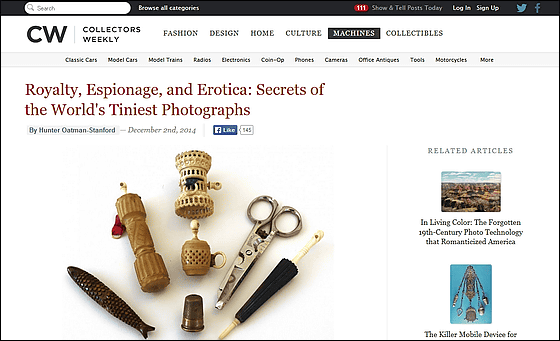What is the reason why the world's smallest "microphotograph" prevailed in the 19th century?

A generation that never saw or touched a film cameraAlthough it appears, in the mid-nineteenth century "pictures" were invented several decades later, the world's extremely small size of 1/8 inch (3.175 mm) which can hardly be seen with the naked eyeMicro photo/Microfilm"Was developed and showed a big trend all over the world at that time. It is summarized how such microphotography was used together.
Royalty, Espionage, and Erotica: Secrets of the World's Tiniest Photographs | Collectors Weekly
http://www.collectorsweekly.com/articles/secrets-of-the-worlds-tiniest-photographs/

Initially when microphotography was invented, contents could not be seen without a microscope, but a small "Stanop lensThe appearance of microscopic photographs with the naked eye became available.
At that time, pocket watches with stannoops and lenses at the time were prevalent as it was able to see secret pictures that can not be confirmed by the naked eye. After that the microphotograph was also active as a spy tool during wartime as well as private usage. I first invented such a microphotographJohn · Benjamin · dancer. The dancer who worked for a scientific equipment maker in the UK had touched the microscope on a daily basis, he said that he came up with ideas for microphotography.
The first time a dancer put in a microphotograph was a physicistWilliam StarjeanIn the name of the gravestone of the tomb, the following is the real picture. There is an extremely small picture on the left side, but as you can see it through the microscope like the right side, the captured content can be read as clear.

Since the photograph of the dancer of those days had to be placed on expensive exclusive slide, it did not spread widely in general. Meanwhile, Parisian photographer Renée Douglon, who was keen on microphotography, succeeded in developing stenoop lenses that will be used for more than 50 years as a result of easy thinking about how to handle microphotography. His idea that microphotography is unlimited with just a single small lens is the first time in 1859 we acquired a patent for microphotography.
A small stenoop lens can be loaded into a Tokutoku knife as follows and it is a mechanism that allows you to see microphotographs contained inside by light through light with the naked eye.

Since then Dagron got an international patent for Stanop lenses, binoculars, pen, letter opener, and dressmaker boxes with built-in stenoops and lenses all over the world have been made.

In addition, Dagron was developing a camera that can take multiple microphotographs with one camera. Early cameras were only capable of shooting eight micro photographs, but at the end of the 1860's, Dagron products succeeded in developing cameras that can take 450 dots of microphotographs on only one side, In 1862, he also exhibited in the world exposition held in London.

In general, the camera was a luxury item, but with Stanop products that can take extremely small pictures at low prices, people can carry around with family memories and holiday events, etc. in microphotography, I began to get a big fashion inside. In addition to the calendar and religious statues, it seems that there were many times carrying microphotographs containing male and other figures of women without hail.

In addition, since Dagron established a technique to put handwritten characters in microphotographs, it was also used as a communicative tool using a traditional butt, besides personal use. In 1870French warIn the city of ParisPrussiaWhen the occupation was occupied by the troops of the government, there are still records that the government used it for information communication.
In addition, due to its characteristics, many stannop products are made difficult to understand where the lenses are attached, and sometimes it is sold unnoticed as a stenop product in antique markets. People who find Stanop products are called "stunop attitudes" among collectors because they take the attitude of seeing the products transparent to light with their hands. Because I heard that microphotographs contained in Stanop products that were sleeping unknowingly were sometimes found valuable historically, if I found an antique city when traveling abroad, a small lens was attached Looking for miscellaneous goods may yield unexpected bargains.

Related Posts:







